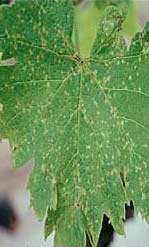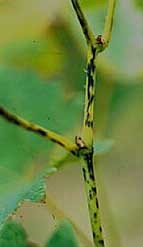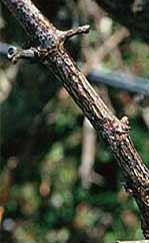Phomopsis cane and leaf spot of grapevines
Phomopsis cane and leaf spot of grapevines is caused by the fungus Phomopsis viticola.
For many years this disease has been known as 'dead arm'. It has been shown that dead arms and pruning wound cankers may also be caused by the fungus Eutypa lata and other fungi and not necessarily by Phomopsis viticola. For this reason the name 'dead arm' is now considered misleading, and the disease is referred to as 'phomopsis cane and leaf spot'.
The disease is favoured by wet spring weather, and is widespread in many of Victoria's wetter, cooler regions. It can often be confused with the grapevine disease black spot.
With phomopsis the small, black, dead spots are surrounded by a yellow halo. With black spot, the dead spots are larger and not surrounded by a yellow halo.
Phomposis occurs in grape growing areas along the Murray River from north-east Victoria (Rutherglen-Wahgunyah) to Mildura. The incidence of phomopsis in the Mildura and Robinvale districts has been low compared to other areas such as Swan Hill and Rutherglen. Affected vines commonly lack vigour and do not crop to their potential.
Currently there are no resistant cultivars available (CABI, 2020. Phomopsis viticola (Phomopsis cane and leaf spot) in 'In Invasive Species Compendium'. Wallingford, UK: CABI International).
Most Vitis vinifera varieties can be infected by phomopsis but not all are affected sufficiently to cause economic loss.
Some table grape varieties are quite susceptible to damage, particularly:
- Waltham Cross
- Purple Cornichon
- Thompson seedless (sultana)
- Cardinal
Among the wine grape varieties, Grenache and Tokay are particularly susceptible.
Two types of phomopsis have been described in the past:
- taxon 1
- taxon 2
Taxon 1 has now been identified as the sexual stage Diaporthe perjuncta, and the symptoms and potential damage have yet to be defined.
Taxon 2 is Phomopsis viticola and is the one described on this page.
Phomopsis symptoms
Infections occur on leaves, shoots and bunches.
Leaf symptoms
Tiny dark brown to black spots rarely greater than 2mm diameter with a 2 to 3mm wide yellow halo around the dead spot (Figure 1). The spots appear 3 to 4 weeks after rain and mainly on the lower leaves on a shoot.

With heavy infection, basal leaves become quite distorted and may not develop to full size.
Petioles may yellow off and abscise, causing leaf drop.
Later developing uninfected leaves often cover the infected basal leaves and the problem is not so noticeable.
Shoot symptoms
Small spots with black centres also appear on shoots in spring, usually at the base of the shoot. These can expand and join up into thin black cracks about 5 to 6mm long (Figure 2).

When infections are severe, the thin cracks join together to produce elongated brown to black legions up to 20mm long. These may open up and become scabby looking.
Heavily infected shoots usually lack vigour and may not develop fully; some are completely girdled and die.
Bunch symptoms
Occasionally, spots similar to those on shoots and leaves also develop on the flower cluster or bunch stem. Severely infected bunches shrivel and die.
Cane symptoms
Canes become discoloured, with dark brown or black patches surrounded by white bleached areas (Figure 3). The infected patches may become speckled with the tiny black fruiting structures (pycnidia) of the phomopsis fungus. The latter mostly develop around original lesions or at nodes.

Crop losses caused by phomopsis are mainly associated with the breakage and loss of heavily scarred shoots. This weakening may also lead to loss of infected canes or spurs, all of which reduce potential bunch number and yield.
If canes weakened by infection are retained at pruning time, they are more susceptible to frost damage.
Life cycle of phomopsis
The disease overwinters in the woody parts of the vine and infection initially occurs in the spring. Spores released from the over-wintering pycnidia on canes and wood infected in previous seasons are splashed by rain onto newly developing shoots.
At least 10 hours of rain is required for spores to be released and subsequent periods of high humidity favour the disease.
Growth occurs over a wide range of temperatures but hot temperatures in summer stop it developing.
Infection requires prolonged periods of free moisture to be present on the unprotected green tissue. Heavy rains for extended periods in September, October and November are particularly favourable for disease development.
The disease tends to spread slowly from localised sources within a vineyard.
Managing phomopsis
Monitoring for the disease should start about 3 weeks after budburst, and then 1 to 2 weeks after that if wet conditions persist.
For the protection of developing shoots and foliage in spring, apply chemicals according to label directions through a properly calibrated and adjusted spray machine. Spray initially at bud break, again when shoots are 100 to 150mm long, and then at fortnightly intervals while conditions favouring the disease persist. Up to 5 sprays may be required.
Locate sections of the vineyard where phomposis occurs and inspect those areas in winter for signs of the disease. Where practicable, prune out badly infected canes and spurs which provide inoculum for new infections.
For information on currently registered and or permitted chemicals, check the Australian Pesticide and Veterinary Medicine Authority (APVMA) website and always consult the label and Safety Data Sheet before using any chemical product.
When establishing new vineyards, care should be taken to select cuttings for propagation from vines free of phomopsis, as the disease is readily introduced to a vineyard, with infected planting material.
Reporting an unusual plant insect pest or disease
Report any unusual plant pest or disease immediately using our online reporting form or by calling the Exotic Plant Pest Hotline on 1800 084 881. Early reporting increases the chance of effective control and eradication.
Please take multiple good quality photos of the pests or damage to include in your report where possible, as this is essential for rapid pest and disease diagnosis and response.
Your report will be responded to by an experienced staff member, who may seek more information about the detection and explain next steps.
Report online